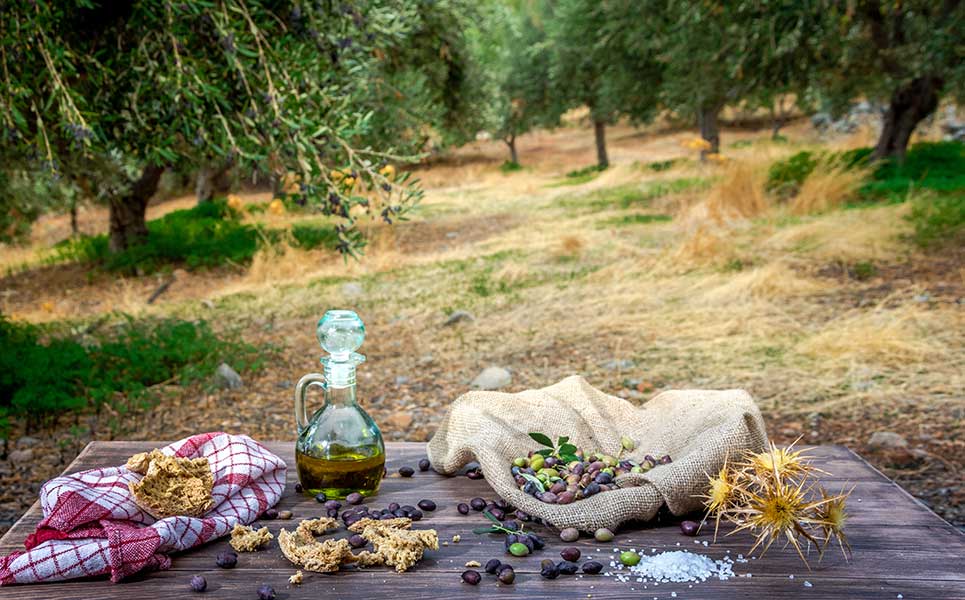Traditional Cretan Food: From Farm to Table at...
Experience Crete’s slow food philosophy where...

Like olive oil and olives, the "dypiros artos" or paximadi rusk has been a part of the Greek diet since ancient times.
© Shutterstock
You may have noticed them at the supermarket, row after row of transparent bags by different brands, filled with brown or white bread rusks, or discovered them at a taverna at the bottom of a Cretan-style salad, known as dakos.
A key component of the Greek diet since the Middle Ages, (ca. 10th century AD), and derived from the ancient Greek dipyros, which means “twice-baked,” paximadi are today produced in a variety of shapes, and with different seeds and grains; a tasty, nutritious, and filling accompaniment to many a meal. There is a great choice of rusks on offer, seasoned with herbs and spices, and even sweet versions flavored with orange, sugar, fennel seeds, or cinnamon.
Paximadi, in all their various forms, have been a culinary staple for millennia. Their portability, long shelf life, resistance to mold, and nutritional value have helped sustain countless generations of Greeks in the countryside and cities alike, especially in times of hardship and occupation. Rusks have even been used, along with coins, clothes, cheese and salted pork, as a form of currency in the past.
In her paper for the Oxford Symposium on Food and Cooking, the historian and author Aglaia Kremezi writes, “Many believe that the word paximadi comes from Paxamus, a cook and author who had probably lived in Rome the first century AD. As food historian Andrew Dalby points out, from this Greek word came the Arabic bashmat or baqsimat, the Turkish beksemad, the Serbo Croatian peksimet, the Romanian pesmet, and the Venetian pasimata.”
Paximadi are double-baked in an oven, traditionally wood-fired, to the point where they reach a hard, crunchy consistency. The key ingredients vary. Most commonly they’re made using a mixture of barley, wheat and rye, or a combination of all three. Today, you can find rusks that are cream colored and fluffy, with a high olive oil content, black rusks made with carob flour, and others made from a blend of flours.
The “paximadi tis katohis,” the rusk created during the great famine in Athens during WWII, contained barley, carob, wheat and oat flours, and, for many, it was key to survival. Today, it is still sold for its high nutritional value.
The greatest inspiration behind “paximadi-mania” in recent years comes from the island of Crete, where the large round “dakos” rusk made from barley flour or a mix of barley and wheat flour, is softened by being soaked in water and then topped with chopped tomato, a drizzle of olive oil, crumbled white cheese (usually feta), and capers or olives.
While paximadi have long been a common household staple in Greece, and among the communities of the diaspora, an increasing number of chefs from abroad have adopted the humble rusk for experimentation, creating all kinds of new and exciting dishes. Crushed and crumbled, paximadi are being used as a textural topping, soaked and mixed with herbs as a stuffing, and broken into chunks as a replacement to croutons in salads and soups. Sweet renditions are also served instead of Italian biscotti along with coffee or crumbled into ice cream.
The darker rusks are generally the highest in nutritional value. Overall, rusks contain good amounts of fiber, as well as magnesium, folic acid, B vitamins (especially B1 and B6) and iron, while carob rusks contain vitamins A, C and D.
Experience Crete’s slow food philosophy where...
These sites may not make every...
Cretan cuisine lives on from home...
In Margarites, Crete’s historic pottery village,...